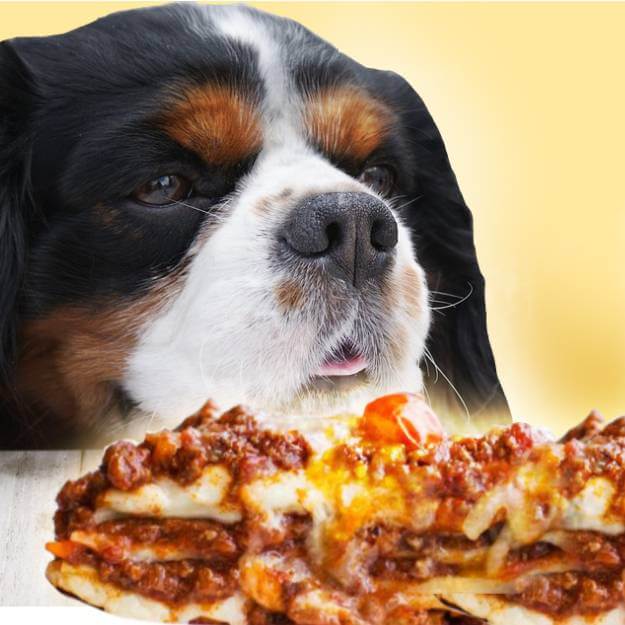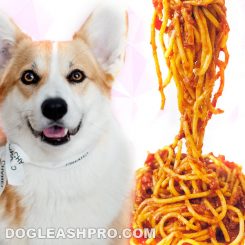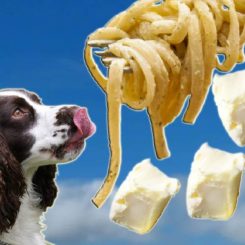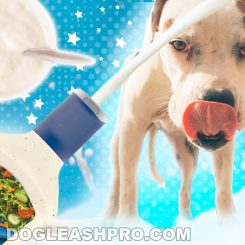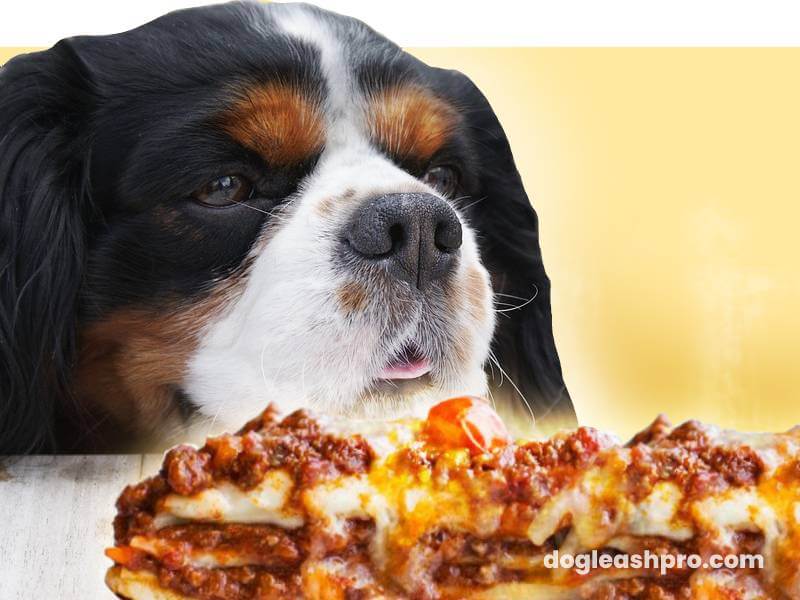
No, dogs should not eat Lasagna. Lasagna is made specifically for human consumption and not to be eaten by your beloved dog. If ingested in small portions, the effects may not be severe, but this practice is generally discouraged due to the combination of ingredients used to make Lasagna.
Like many human foods, Lasagna is made with several ingredients including onion and garlic that are dangerous for dogs.
Table of Contents
Is Lasagna bad for dogs?
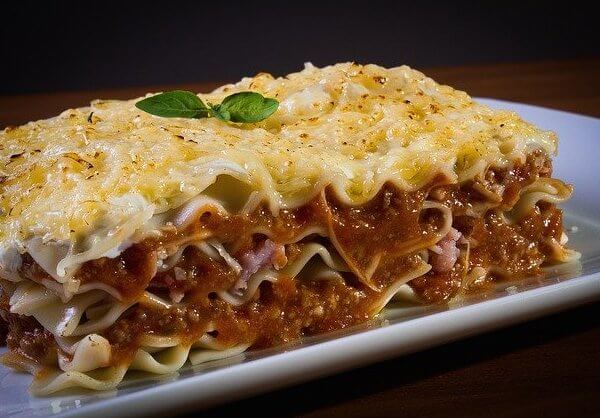
Lasagna is a casserole and originates from Italy. It is made of the following ingredients:
- Ground meat.
- Onion.
- Garlic.
- Pepper.
- Italian spices (Oregano, basil, and cheese).
First, the ground meat is cooked using the stovetop method, and the seasonings and tomato sauce are added in for flavor.
In a separate pan, thinly square-shaped pasta is boiled till cooked. In a baking dish, one layer of pasta is placed, followed by a layer of the ground meat mixture and this continues until all the ingredients are used up.
The top layer must be pasta. This is then covered with cheese, and the type and amount used are based on personal preference. The casserole is then placed into the oven and baked on average for 45 minutes at 375 degrees. It is this combination of ingredients that makes Lasagna bad for your dog.
Why is Lasagna not safe for your dogs?
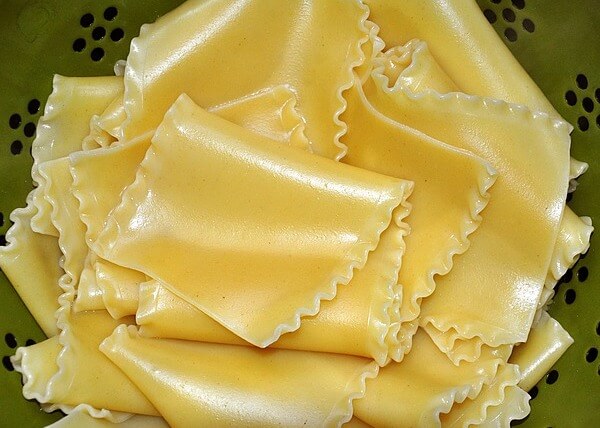
Of the ingredients listed above, the only ones that are not harmful to your dog are:
- Ground meat.
- Basil.
- Pasta.
Let’s dive deeper into each of the ingredients used and why it may be harmful to dogs. Here is a list of reasons why Lasagna is not safe for your dog:
1. Onion and Garlic
The amount of onion or garlic fed to your dog at any point in time should never exceed the equivalent of .005% of his body weight. For example, if your dog weighs 20 pounds, then no more than 0.001 pounds of garlic or onion should be fed to your dog. Consuming more than this amount could result in anemia and a low red blood cell count. This can easily happen if dogs accidentally eat Lasagna.
2. Pepper
When consumed in small portions, it is generally safe for dogs. However, should a significant amount of pepper be used in the Lasagna, this can lead to an upset stomach for your dog.
3. Oregano
Like pepper, if your pooch consume a large amount, this could negatively impact your dog’s digestive system causing him to vomit or have diarrhea. In more severe cases, it has also been known to lead to stomach ulcers, a reduced heart rate, and low blood pressure.
4. Cheese
If your pup is lactose-intolerant, avoid dairy products like cheese. Consuming cheese could result in vomiting or diarrhea. Otherwise, if your pup can handle dairy products, then cheese should be eaten in moderation.
What are the health problems of feeding your dog Lasagna?
The following are health problems along with symptoms and side effects that could result if you feed your dog Lasagna or your pup ate too much Lasagna:
Anemia
Anemia is the reduction of red blood cell levels in your dog. Some symptoms of anemia include the following:
- Inactive.
- Not playful.
- Not energized in comparison to usual energy levels.
- Marks on your canine’s skin due to a decrease in blood platelets.
- Change in gum color (white or light pink color).
- Dark-colored bloody stool.
- Blood in vomit.
Heinz body formation
Heinz body formation occurs when the toxins damage the red blood cells. These damaged red blood cells are then viewed as a threat to the dog’s body and something that the body needs to be dispelled. The symptoms of Heinz body formation are similar to that of anemia.
Upset stomach
An upset stomach is caused by a poor diet, particularly if your four-legged friends eat the wrong food or if a generally safe food is consumed in excessive amounts. Symptoms of an upset stomach include:
- Vomiting.
- Diarrhea.
- Frequent passing of gas.
- Stomach noises.
- Reduction in appetite.
Stomach ulcers
Dogs will have stomach ulcers as a result of poor eating habits. Your pooch may experienced the following symptoms:
- Reduced appetite.
- Reduction in energy levels or activity.
- Dehydration.
- Change in gum color.
Low blood pressure
Poor diet practices can trigger low blood pressure. Low blood pressure is when there is a reduction of oxygen and nutrients being distributed to major organs and as a result, the organs are not operating at ideal levels. Due to this, the organs will weaken and in extreme cases possibly leading to organ failure. Symptoms include the following:
- Change in gum color.
- Fainting.
- Increased urination.
- Weakness.
Why is tomato sauce in Lasagna dangerous for your dogs?
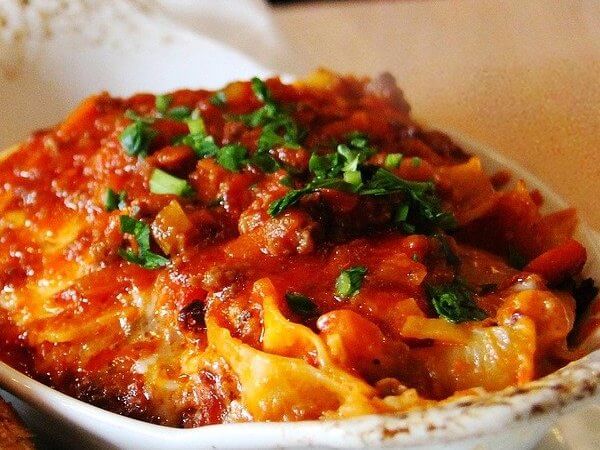
Tomato sauce is one of the key ingredients in Lasagna that is harmful to your dog because it contains onion, garlic, and high salt content. Similar to humans, a high salt diet in dogs can lead to dehydration. Tomato also contains a chemical called tomatine which can be toxic to dogs.
Therefore, if you would like to share your food with your canine, make sure you’re not using toxic ingredients like onion, garlic, or salt in that dish.
What happens if your dogs eat Lasagna?
If your furry friends eat Lasagna, it’s important to observe them carefully and bring them to your vet immediately if you’re seeing the signs and symptoms we discussed above.
While Lasagna noodles are fine, it is the ingredients in the Lasagna dish that can be problematic for dogs. If ingredients like onions and garlic are being used in this dish, it can cause onion or garlic poisoning in dogs. In severe cases, it can also cause oxidative damage to your pooch.
Find out how much of the Lasagna your pup ate. If he consumes just a tiny amount, a single onion is fine. However, consuming a lot of onion is the dangerous part. If your canine ate a lot of the Lasagna, bring him to the vet as soon as you can. Eating a lot of onions can cause hemolytic anemia in dogs.
Hemolytic anemia means that your canine’s red blood cells (RBC) will be destroyed and he may start to have a hard time breathing. In severe cases, onion poisoning can be deadly.
Your vet will know what to do and how to treat your dog with onion poisoning. She may induce your furry companion to vomit using activated charcoal. In serious cases, your pup may need a blood transfusion.
What to do if your dog eats Lasagna?
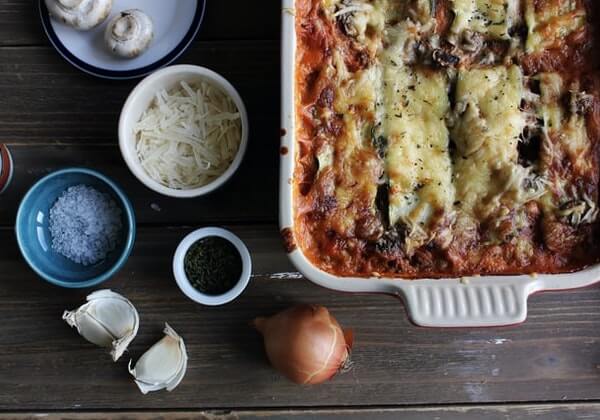
If your dog accidentally ate a lot of Lasagna, we strongly advise that your pup seek immediate medical attention. Just as a guide, the larger your dog, the less likely he will be impacted by Lasagna consumption.
Of course, the smaller the portion of the Lasagna that was eaten, the less severe the implication would be to their health.
It is important to note that certain dog breeds such as the Akita, in addition to dogs that are on certain types of medication would be at more risk of food poisoning no matter how much Lasagne they consumed.
How to make dogs-friendly Lasagna?
All hope is not lost if you would really like to share a plate of Lasagna with your canine. You can make a dog-friendly Lasagna dish for your canine companion.
Lasagna can be made with lean ground beef, organic zucchini as a Lasagna pasta substitute, or Lasagna pasta and organic basil leaves. Based on your preference, the Lasagna pasta or zucchini is boiled till tender.
The ground beef is cooked with a small portion of basil for flavor and the zucchini or pasta is layered in a baking dish with the cooked ground beef and baked as a casserole. You now have a delicious and safe meal ready for your dog to devour.
How to know if your dog is suffering from onion toxicity?
You can identify onion toxicity symptoms if your dog is vomiting, has diarrhea, experiences a change in gum color (bluish or pale), increased salivation, reduction in energy levels or activities, increase in usual heart rate, or fainting.
When to visit your vet
From the onset of the symptoms described above, it is strongly recommended that you seek urgent medical attention. Call your vet immediately and in advance and let her know what symptoms your pup is displaying. This allows your vet to prepare before you and your pup arrives. Immediate action could potentially save your dog’s life.
Treatments if your dog has poisoning from eating Lasagna
If your dog is displaying symptoms of onion toxicity which can happen after digesting Lasagna, you’ll need to visit the vet immediately. Immediate attention and treatment can save your dog’s life.
The good news is that within a few hours of Lasagna consumption, food poisoning can be treated. The vet may induce vomiting to get the Lasagna out of your dog’s system. She may also provide your dog with activated charcoal to get rid of the toxins released in your canine’s system due to the Lasagna.
If neither of these treatments are successful, then the last resort is a blood transfusion for your pup.
Canine-friendly alternatives to Lasagna
As a substitute for Lasagna the following can be fed to your dog:
- Puppy-friendly Lasagna made with basil, organic ground beef, and pasta (or vegetables substituted for pasta). This version of Lasagna is safe for your canine.
- Chicken Casserole made with chicken breast, brown rice, and vegetables. This meal is safe, nutritious, and delicious for your pooch.
- Vegetable Casserole made with brown rice, vegetables, and ground turkey. This is an excellent substitute for Lasagna.
So, can dogs eat Lasagna?
The safest and best response to whether dogs can eat Lasagna is no in order to prevent any emergency trips to the vets and to prevent your pup from falling sick or experiencing any unpleasant symptoms associated with the adverse ailments that arise due to Lasagna consumption by dogs.
Related Questions
If Lasagna is consumed by your puppy, this can be fatal. An older and bigger dog might possibly get very ill but with treatment can improve. However, a puppy’s defense and immune system are weaker, and the onions, garlic and tomato sauce used to make the Lasagna can lead to a fatality.
If your puppy is displaying symptoms of onion or garlic toxicity, chances are they unfortunately may not survive the ordeal.
Lasagna noodles are one of the few ingredients in Lasagna that is safe for a dog to eat, provided your pup isn’t allergic to any of the ingredients used to make pasta – namely flour, eggs, and water. These ingredients are all generally safe for your dog’s consumption. Once it is properly cooked with no salt, you can serve it to your pooch.
If the pasta is uncooked, this would be unsafe for dogs, as the sharp pieces of the pasta can cause a tear in the digestive tract which would lead to internal bleeding.
DISCLAIMER: THIS WEBSITE DOES NOT PROVIDE MEDICAL ADVICE
The information, including but not limited to, text, graphics, images and other material contained on this website are for informational purposes only. No material on this site is intended to be a substitute for professional veterinary advice, diagnosis, or treatment. Always seek the advice of your veterinarian or other qualified health care provider with any questions you may have regarding dietary needs.
Resources:
https://en.wikipedia.org/wiki/Lasagne

With over five years of specialized experience as an animal writer, my expertise lies in dog nutrition, health, behavior, grooming, and training. I am dedicated to delivering helpful and informative content that caters to the well-being of our furry friends. My primary goal is to empower pet owners with knowledge and ensure our canine companions thrive in health and happiness. In my free time, I love volunteering at local dog rescue centers.
